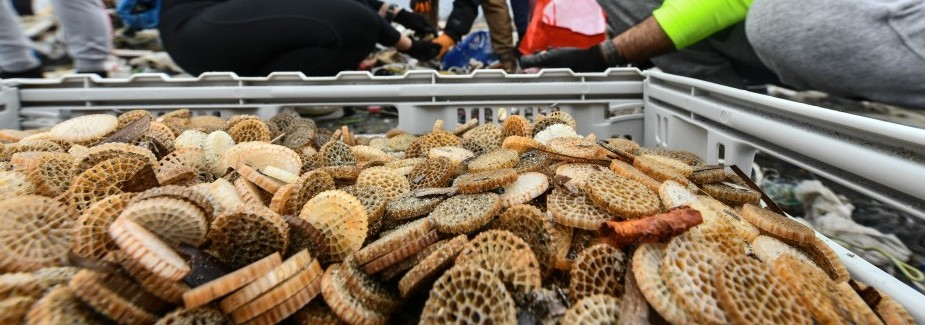Last February, Mare Vivu found more than 40 000 biomedia over only a few kilometers square of beach. All in one beach cleanup?
By the end of 2020, we were alerted by several inhabitants of la Marana (Corsica, France) of the presence of large quantities of biomedia beached in several places of the lagoon. After scouting several sites, we decided to rally citizens around a huge beach cleanup operation in 3 sites of la Marana, simultaneously. The objective was, firstly to better understand the scale and the geographical repartition of these pollution and to identify their potential source. The second objective, also very important, was to create the buzz around this pollution and inform the population. Our idea was to alert journalists and representatives and to get them involved in the case.
Outside of the geographical repartition, this collect helped you understand a bit more the type of biomedia present on the island: were they all similar in terms of sizes and shapes?
Most collected biomedia during this February operation were K5 type ones. Their quantities were absolutely frightening (tenth of thousands of biomedia), spread in very localized areas, and they had a brown color. These 3 elements led us to believe that a recent incident happened in a close treatment plant using specifically this type of biomedia. Howewer, we only found those type of biofilm filter, in La Marana’s beach since 2019. Until 2020, there were small quantities.
Other types of biomedias can be found all around Corsica’s coastline, even in important quantities: for example, tenths of K3 were found in one site in Cap Corse and, on a Conca d’Uru beach, we took a census of 7 types of different biomedia, and thousands of plastic pellets!
We understand that this type of pollution has become one of the major concerns of Mare Vivu’s members. How did you end up get interested in this issue, and what development have you observed since 2016?
It is thanks to our collaboration with Surfrider Europe that we got interested in biomedia. We were often finding more or less big amounts during beach cleanups. However, the pollution that happened in Marana’s lido was far off in terms of gravity and scale, even if since 2019 we experienced several waves of hundreds of K5 biomedia in the lagoon. To this day [end of June 2021], K5 biomedia’ quantities beached, almost everyday, in the lagoon are still very impressive (around hundreds of thousands). But these biomedia are now reaching the entire west Corsica’s coastlines: we thus have found some from the North of Cap Corse up to the extreme southwest, east of Bonifacio. We even have found some in several places of the west coast, even though it is difficult to tell whether they are from the same source of pollution of another.
To better follow the scale of these pollutions, we created a network of citizen alert, and an interactive map materializing all the reports done to our organization. In less than 2 months, we went over 50 reports across Corsica.
Can you tell us a bit more on this alert network?
Citizen reports give us continuous information on sites impacted by this pollution. These data are extremely useful, in case of any juridical process against the constructor of the wastewater treatment plant. But they also allow our organization to react very quickly in case of localised pollution (by alerting communal agents) and evaluate these pollutions’ inertia to better anticipate their propagations.
A good tool to pressure people responsible for this pollution?
In parallel, with Surfrider Europe’s support, we are often working and sharing with Bastia’s conurbation committee, and South Bastia’s wastewater treatment plant team, that fortunately cooperate. After February’s beach cleanup, the technical breakdown of the plant was quickly corrected to prevent any new incidents. Our objective is now to showcase the set-up solutions to other plants that might experience the same failures. Unfortunately, harm is done, huge quantities were accidently spilled in the sea, and we need to anticipate frequent arrival on our coastlines, but also on other Mediterranean coasts: by comparison we are still finding on our coasts Italian biomedia spilled accidently during a major failure in Salerno, more than 2 years ago.
What are the next steps?
We also asked South-Bastia’s plant to collect biomedia gathered by citizens to reinject them in their basins, and to publicly communicate to shed the light on this major incident. Also, during next CorSeaCare mission of Mare Vivu, we will be especially focused on biomedia, and will monitor the pollution all around Corsica.
Many thanks to Pierre-Ange for these precisions and good luck to all Mare Vivu members for their coming fights.

